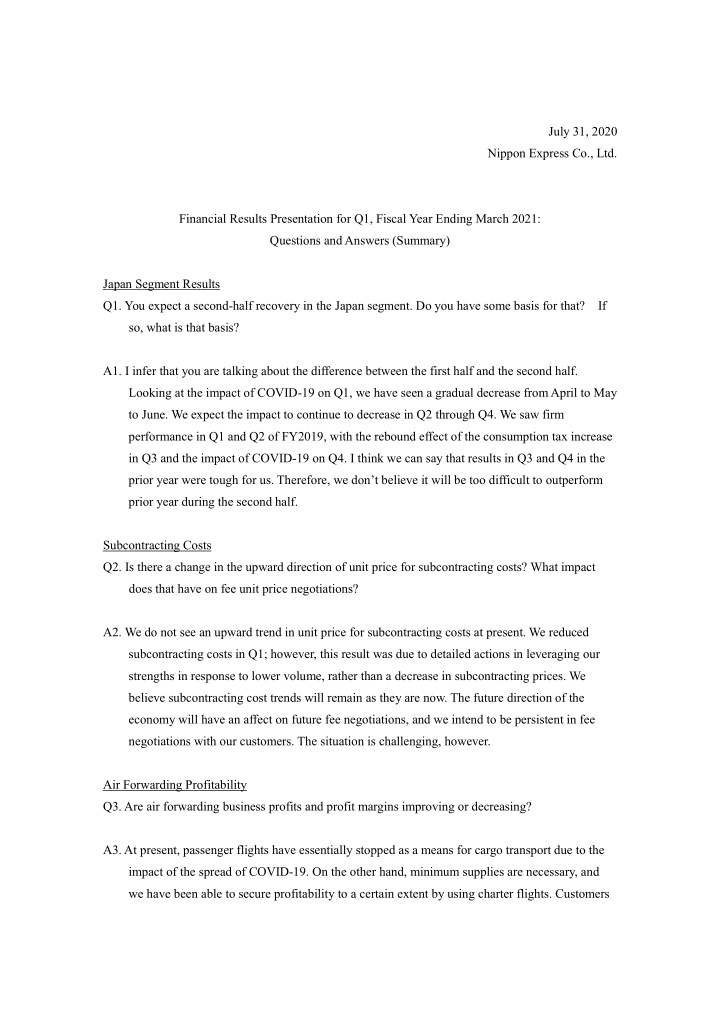



July 31, 2020 Nippon Express Co., Ltd. Financial Results Presentation for Q1, Fiscal Year Ending March 2021: Questions and Answers (Summary) Japan Segment Results Q1. You expect a second-half recovery in the Japan segment. Do you have some basis for that? If so, what is that basis? A1. I infer that you are talking about the difference between the first half and the second half. Looking at the impact of COVID-19 on Q1, we have seen a gradual decrease from April to May to June. We expect the impact to continue to decrease in Q2 through Q4. We saw firm performance in Q1 and Q2 of FY2019, with the rebound effect of the consumption tax increase in Q3 and the impact of COVID-19 on Q4. I think we can say that results in Q3 and Q4 in the prior year were tough for us. Therefore, we don’t believe it will be too difficult to outperform prior year during the second half. Subcontracting Costs Q2. Is there a change in the upward direction of unit price for subcontracting costs? What impact does that have on fee unit price negotiations? A2. We do not see an upward trend in unit price for subcontracting costs at present. We reduced subcontracting costs in Q1; however, this result was due to detailed actions in leveraging our strengths in response to lower volume, rather than a decrease in subcontracting prices. We believe subcontracting cost trends will remain as they are now. The future direction of the economy will have an affect on future fee negotiations, and we intend to be persistent in fee negotiations with our customers. The situation is challenging, however. Air Forwarding Profitability Q3. Are air forwarding business profits and profit margins improving or decreasing? A3. At present, passenger flights have essentially stopped as a means for cargo transport due to the impact of the spread of COVID-19. On the other hand, minimum supplies are necessary, and we have been able to secure profitability to a certain extent by using charter flights. Customers
require some cargo regardless of soaring fares, and we have secured profitability for cargo from Japan between April and June. Although there are differences across regions overseas, passenger flights out of Asia have almost all been canceled. Here, we moved quickly to secure charter flights, negotiating and receiving fair fees from our customers. We believe the profitability of the air forwarding business is improving, even on a global level. First Half Results Outlook Q4. Compared to Q1, you plan for significantly improved operating income in Q2. In what area particularly do you expect an improvement? A4. We believe the impact of COVID-19 on Q2 will be half that of Q1. Our results overseas, actually January through March for Q1 and April through June for Q2, show that East Asia, particularly China, suffered the impact of COVID-19 at an early stage in January, quickly entering a recovery after. Between April and June, we saw spot demand in air freight volume in South Asia and East Asia, demonstrating a positive impact from COVID-19. We expect that this will lead to a significant improvement in Q2 operating income compared to Q1. Details on the Impact of COVID-19 Q5. Can you provide more detail about the impact of COVID-19? On P.6 of your financial results presentation, you show and operating loss of ¥9.2 billion and a full-year loss of ¥20.7 billion on P.12. Can you provide more details about these numbers? A5. We do not have numbers that show the detailed impact of COVID-19 by certain categories in Japan or certain categories overseas. In terms of trends, we saw both pluses and minuses. The minuses include lower quantity, weight and decreased warehouse handling. The pluses include demand for emergency transport of air freight volume, as customer supply chains experienced delays. Using charters flight to meet emergency spot demand turned into a positive factor. Our final numbers are the results of adding these pluses and minuses. Compared to overseas, Japan experienced overwhelmingly negative factors, while overseas, in contrast, more positive factors. Impact of COVID-19 on East Asia and South Asia Q6. The full-year forecasts on P.36 of your results presentation, you show the impact of COVID-19 to be a significant positive factor on earnings in East Asia and South Asia and Oceania. Why is that? What kind of impact are you expecting?
A6. Due to the COVID-19 pandemic, aircraft space for emergency material transport is very tight this fiscal year. Here, we have put together flexible combinations to secure space strategically and effectively. We expect intra-Asia, especially East Asia, to experience relatively firm performance and that the impact of COVID-19 will be an overall positive with respect to income. We have seen the lower limit for air transportation volume in the global supply chain for East Asia and South Asia and Oceania. We have secured a certain amount of air transportation procurement, and volume will change according to economic cycle and market expansion. In particular, we absolutely expect that the market will demand semiconductor transport for next- generation technologies and the automotive industry, which requires just-in-time supply. Air transportation is becoming more important in East Asia and South Asia, which have become parts suppliers. Given these circumstances, we believe a recovery in travel, which is subject to the political judgment of every individual country, will be difficult for the time being due to COVID-19. Therefore, we will see the consistent use of daily passenger flight charters, rather than cargo charters or freighters. Because air carriers provide passenger space for cargo. Applying contract fees will be difficult in this case. Depending on the market, we will apply spot fares in the future as well. In addition, we believe arrivals and departures, round trip transport, in other words, will lead to improved profitability and have a positive impact on customer demand. End
Recommend
More recommend